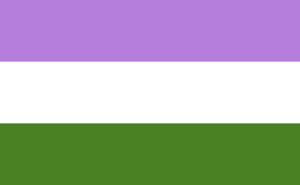Marilyn Roxie

About Marilyn Roxie[edit]
Marilyn Roxie is a video artist and experimental photographer exploring androgyny, male submission, queer subculture, and the relationship of found image and creative authorship. Founder of Creative Commons netlabel Vulpiano Records.[1] Roxie uses they/them pronouns and self identifies as genderqueer.[2]
The Creation of the Gender Queer Flag[edit]
In 2010 Marilyn Roxie started their work on the Genderqueer flag in response to a school project and posted the final version on their personal blog in June 2012.[3] Genderqueer as Ash Hardell describes it is, “Someone whose gender exists outside of or beyond society’s binary concept of gender, often by not conforming to it.”[4] As many genderqueer people, Roxie noticed early on the lack of representation for their community so they decided to bring awareness about with this flag.[5]
When creating the flag each individual color was chosen with deliberation and given immense weight in meaning. In an interview with The Buzz magazine they told Casey that they included lavender due to the “queerness” of it and its history within the community. They are referencing the noble act of queer women taking space in a cisgender[6] white straight feminist conference in 1970.[7] As well as they talked about how lavender is the result of mixing pink and blue which are typically binary gendered colors, to imply that one is, both but neither at the same time. The white represents neutrality, or without gender to include those who may feel genderless. The green is the direct inverse of lavender to represent all other people a part of the community. Roxie wanted to try to include all people in the community, from a-gender, gender fluid, non binary, etc.[3] So, one way that they approached that task is they created many different versions of the flag to make it as appealing to the viewer and as easy to copy to distribute as possible. After publishing the flag on their blog , they did include that the flag’s design is open to the public's use which is why although the flag is commonly known and accepted but, the creator is not. Roxie created the flag for their community to have and to cherish but due to ignorance on the community’s part, sometimes they assume the flag is referencing the British suffragette movement.
Roxie’s flag does often receive backlash due to its similarity to the British suffragette flag. As Roxie’s flag gained more popularity and they were made aware of the two flags similarities and they released a statement on their blog to explain themselves.[2] They feel although that their flag was created with such deliberation and thought about their communities that they have no plans to change their design. They understand some transphobic people will use the flag as queer-bait but they warn their listeners to look out for it and report it.[8]
Although there is very little information on the internet about genderqueer people, Roxie’s flag continues to be a staple for all genderqueer individuals and a reminder to the community of their existence.The genderqueer flag remains as a symbol of hope for many of the trans identified individuals that one day gender variant people will be widely accepted.
References[edit]
- ↑ "Marilyn Roxie". Marilyn Roxie. Retrieved 2019-06-06.
- ↑ 2.0 2.1 "On the Genderqueer and Non-Binary Flag and Suffragette Colours in the UK". GENDERQUEER AND NON-BINARY IDENTITIES. Retrieved 2019-06-06.
- ↑ 3.0 3.1 "The Genderqueer Flag in 2019". GENDERQUEER AND NON-BINARY IDENTITIES. Retrieved 2019-06-06.
- ↑ Mardell, Ashley (November 9, 2017). The ABC's of LGBT+. Mango. Search this book on

- ↑ "Marilyn Roxie: Genderqueer Flag Designer / Founder of Vulpiano Records". TheBUZZ Magazine. 2015-02-26. Retrieved 2019-06-06.
- ↑ "Cisgender", Wikipedia, 2019-05-07, retrieved 2019-06-06
- ↑ writer, Linda Napikoski Linda Napikoski is a; feminism, grassroots activist with a J. D. international law Her editorial focus is on; Rights, Global Human. "Lavender Menace: the Phrase, the Group, the Controversy". ThoughtCo. Retrieved 2019-06-06.
- ↑ "Queerbaiting", Wikipedia, 2019-06-06, retrieved 2019-06-06
This article "Marilyn Roxie" is from Wikipedia. The list of its authors can be seen in its historical and/or the page Edithistory:Marilyn Roxie. Articles copied from Draft Namespace on Wikipedia could be seen on the Draft Namespace of Wikipedia and not main one.
